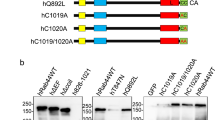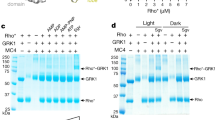Abstract
C2 domains are widespread protein modules that often occur as tandem repeats in many membrane-trafficking proteins such as synaptotagmin and rabphilin. The first and second C2 domains (C2A and C2B, respectively) have a high degree of homology but also specific differences. The structure of the C2A domain of synaptotagmin I has been extensively studied but little is known about the C2B domains. We have used NMR spectroscopy to determine the solution structure of the C2B domain of rabphilin. The overall structure of the C2B domain is very similar to that of other C2 domains, with a rigid β-sandwich core and loops at the top (where Ca2+ binds) and the bottom. Surprisingly, a relatively long α-helix is inserted at the bottom of the domain and is conserved in all C2B domains. Our results, together with the Ca2+-independent interactions observed for C2B domains, indicate that these domains have a Janus-faced nature, with a Ca2+-binding top surface and a Ca2+-independent bottom surface.
This is a preview of subscription content, access via your institution
Access options
Subscribe to this journal
Receive 12 print issues and online access
$209.00 per year
only $17.42 per issue
Buy this article
- Purchase on Springer Link
- Instant access to full article PDF
Prices may be subject to local taxes which are calculated during checkout







Similar content being viewed by others
References
Nalefski, E. A. & Falke, J. J. The C2 domain calcium-binding motif: structural and functional diversity. Prot. Sci. 5, 2375–2390 (1996).
Rizo, J. & Südhof, T. C. C2 domains, structure and function of a universal Ca2+-binding domain. J. Biol. Chem. 273, 15879–15882 (1998).
Nishizuka, Y. The molecular heterogeneity of protein kinase C and its implications for cellular regulation. Nature 334, 661– 665 (1988).
Perin, M. S., Fried, V. A., Mignery, G. A., Jahn, R. & Südhof, T. C. Phospholipid binding by a synaptic vesicle protein homologous to the regulatory region of protein kinase C. Nature 345, 260–263 (1990).
Brose, N., Hofmann, K., Hata, Y. & Südhof, T. C. Mammalian homologues of Caenorhabditis elegans unc-13 gene define novel family of C2 domain proteins. J. Biol. Chem. 270 , 25273–25280 (1995).
Sutton, R. B., Davletov, B. A., Berghuis, A. M., Südhof, T. C. & Sprang, S. R. Structure of the first C2 domain of synaptotagmin I: a novel Ca2+/phospholipid-binding fold. Cell 80, 929–938 (1995).
Essen, L.-O., Perisic, O., Cheung, R., Katan, M. & Williams, R. L. Crystal structure of a mammalian phosphoinositide-specific phospholipase Cδ. Nature 380, 595– 602 (1996).
Grobler, J. A., Essen, L.O., Williams, R. L. & Hurley, J. H. C2 domain conformational changes in phospholipase C-δ1. Nature Struct. Biol. 3, 788–795 (1996).
Perisic, O., Fong, S., Lynch, D. E., Bycroft, M. & Williams, R. L. Crystal structure of a calcium-phospholipid binding domain from cytosolic phospholipase A2. J. Biol. Chem. 273, 1596–1604 (1998).
Xu, G.-Y. et al. Solution structure and membrane interactions of the C2 domain of cytosolic phospholipase A2 . J. Mol. Biol. 280, 485–500 ( 1998).
Sutton, R. B. & Sprang, S. R. Structure of the protein kinase C-β phospholipid-binding C2 domain complexed with Ca2+. Structure 6, 1395– 1405 (1998).
Pappa, H., Murray-Rust, J., Dekker, L. V., Parker, P. J. & McDonald, N. Q. Crystal structure of the C 2 domain from protein kinase C-δ. Structure 6, 885–894 (1998).
Shao, X., Davletov, B. A., Sutton, R. B., Südhof, T. C. & Rizo, J. A bipartite Ca2+-binding motif in C2 domains of synaptotagmin and protein kinase C. Science 273, 248– 251 (1996).
Ubach, J., Zhang, X., Shao, X., Südhof, T. C. & Rizo, J. Ca2+ binding to synaptotagmin: how many Ca2+ ions bind to the tip of a C2 domain? EMBO J. 17, 3921–3930 ( 1998).
Essen, L.-O., Perisic, O., Lynch, D. E., Katan, M. & Williams, R. L. A ternary metal binding site in the C2 domain of phosphoinositide-specific phospholipase C-δ1 . Biochemistry, 36, 2753– 2762 (1997).
Shao, X., Fernandez, I., Südhof, T. C. & Rizo, J. Solution structures of the Ca2+-free and Ca2+-bound C2A domain of synaptotagmin I: does Ca2+ induce a conformational change? Biochemistry 37, 16106– 16115 (1998).
Shao, X. et al. Synaptotagmin-syntaxin interaction: the C2 domain as a Ca2+-dependent electrostatic switch. Neuron 18, 133–142 ( 1997).
Zhang, X., Rizo, J. & Südhof, T. C. Mechanism of phospholipid binding by the C2 A domain of synaptotagmin I. Biochemistry 37, 12395–12403 (1998).
Nalefski, E. A. et al. Independent folding and ligand specificity of the C2 calcium-dependent lipid binding domain of cytosolic phospholipase A 2 . J. Biol. Chem. 273, 1365– 1372 (1998).
Davletov, B. A., Perisic, O. & Williams, R. L. Calcium-dependent penetration is a hallmark of the C2 domain of cytosolic phospholipase A2 whereas the C2A domain of synaptotagmin binds membranes electrostatically. J. Biol. Chem. 273, 19093–19096 ( 1998).
Südhof, T. C. & Rizo, J. Synaptotagmins: C 2 domain proteins that regulate membrane traffic. Neuron , 17, 379–388 ( 1996).
Shirataki, H. et al. Rabphilin-3A, a putative target protein for smg p25A/ rab3A p25 small GTP-binding protein related to synaptotagmin. Mol. Cell. Biol. 13, 2061–2068 (1993).
Orita, S. et al. DoC2: a novel brain protein having two repeated C 2-like domains. Biochem. Biophys. Res. Commun. 206, 439–448 (1995).
Sasakaguchi, G., Orita, S., Maeda, M., Igarashi, H. & Takai, Y. Molecular cloning of an isoform of doC2 having two C2-like domains. Biochem. Biophys. Res. Commun. 217, 1053–1061 ( 1995).
Kwon, O.-J., Gainer, H., Wray, W. & Chin, H. Identification of a novel protein containing two C2 domains selectively expressed in the rat brain and kidney. FEBS Lett. 378, 135–139 (1996).
Geppert, M. et al. Synaptotagmin I: a major Ca2+ sensor for transmitter release at a central synapse. Cell 79, 717 –727 (1994).
Sugita, S., Hata, Y. & Südhof, T. C. Distinct Ca2+-dependent properties of the first and second C2 domains of synaptotagmin I. J. Biol. Chem. 271, 1262–1265 (1996).
Chapman, E. R., An, S., Edwarson, J. M. & Jahn, R A novel function for the second C2 domain of synaptotagmin. J. Biol. Chem . 271, 5844–5849 ( 1996).
Zhang, J. Z., Davletov, B. A., Südhof, T. C. & Anderson, R. G. W. Synaptotagmin I is a high affinity receptor for clathrin AP2: implications for membrane recycling. Cell 78, 751– 760 (1994).
Fukuda, M., Aruga, J., Niinobe, M., Aimoto, S. & Mikoshiba, K. Inositol 1,3,4,5-tetrakisphosphate binding to the C 2B domain of IP4BP/synaptotagmin II. J. Biol. Chem. 269, 29206–29211 ( 1994).
Schiavo, G., Gmachl, N. J., Stenbeck, G., Sollner, T. H. & Rothman, J. E. A possible docking and fusion particle for synaptic transmission. Nature 378, 733–376 (1995).
Sheng, Z. H., Yokoyama, C. T. & Catterall, W. A. Interaction of the synprint site of N-type Ca2+ channels with the C2B domain of synaptotagmin I. Proc. Natl Acad. Sci. USA 94, 5405– 5410 (1997).
Chung, S.-H., Takai, Y. & Holz, R. W. Evidence that the Rab3a-binding protein, rabphilin3a, enhances regulated secretion. J. Biol. Chem. 270, 16714–16718 (1995).
Chung, S.-H. et al. The C2 domains of rabphilin3A specifically bind phosphatidylinositol 4,5-bisphosphate containing vesicles in a Ca2+-dependent manner. J. Biol. Chem. 273, 10240–10248 (1998).
Bommert, K. et al. Inhibition of neurotransmitter release by C2-domain peptides implicates synaptotagmin in exocytosis. Nature 363, 163–165.
Chapman, E. R., Desai, R. C., Davis, A. F. & Tornehl, C. K. Delineation of the oligomerization, AP-2 binding, and synprint binding region of the C2B domain of synaptotagmin. J. Biol. Chem. 273, 32966–32972 (1998).
Perin, M. S. The COOH terminus of synaptotagmin mediates interaction with the neurexins . J. Biol. Chem. 269, 8576– 8581 (1994).
Fykse, E. M., Li, C. & Südhof, T. C. Phosphorylation of rabphilin-3A by Ca2+/calmodulin- and cAMP-dependent kinase in vitro. J. Neurosci. 15, 2385–2395 (1995).
Zhang, O., Kay, L. E., Olivier, J. P. & Forman-Kay, J. Backbone 1H and 15N resonance assignments of N-terminal SH3 domain of drk in folded and unfolded states using enhanced-sensitivity pulsed field gradient NMR techniques. J. Biomol. NMR 4, 845–858 ( 1994).
Kay, L. E., Xu, G. Y. & Yamazaki, T. Enhanced-sensitivity triple-resonance spectroscopy with minimal H2O saturation. J. Magn. Reson. A 109, 129–133 (1994).
Muhandiram, D. R. & Kay, L. E. Gradient-enhanced triple-resonance three-dimensional NMR experiments with improved sensitivity . J. Magn. Reson. B 103, 203– 216 (1994).
Kay, L. E. Pulsed-field gradient-enhanced three-dimensional NMR experiment for correlating 13Ca/β, 13C", and 1Hα chemical shifts in uniformly 13C-labelled proteins dissolved in H2O . J. Am. Chem. Soc. 115, 2055– 2057 (1993).
Grzesiek, S., Anglister, J. & Bax, A. Correlation of backbone amide and aliphatic side-chain resonances in 13C/15N-enriched proteins by isotropic mixing of 13C magnetization. J. Magn. Reson. B 101, 114–119 (1993).
Kay, L. E., Xu, G.-Y., Singer, A. U., Muhandiram, D. R. & Forman-Kay, J. D. A gradient-enhanced HCCH-TOCSY experiment for recording side-chain 1H and 13C correlations in H2O samples of proteins . J. Magn. Reson. B 101, 333– 337 (1993).
Kuboniwa, H., Grzesiek, S., Delaglio, F. & Bax, A. Measurement of HN-Ha J couplings in calcium-free calmodulin using new 2D and 3D water-flip-back methods. J. Biomol. NMR 4, 871–878 (1994).
Delaglio, F., Grzesiek, S., Vuister, G.W., Zhu, G., Pfeifer, J. & Bax, A. NMRpipe: a multidimensional spectral processing system based on UNIX pipes. J. Biomol. NMR 6, 277 –293 (1995).
Stein, E.G., Rice, L. M. & Brunger, A.T. Torsion angle molecular dynamics: a new efficient tool for NMR structure calculation J. Mag. Res. Ser. B 124, 154–164 (1997).
Brunger, A. T. et al. Crystallography and NMR System: a new software suite for macromolecular structure determination. Acta Crystallogr. D 54, 905–921 (1998).
Kraulis, P. J. MOLSCRIPT: a program to produce both detailed and schematic plots of protein structures. J. Appl. Crystallogr. 24, 946 –950 (1991).
Laskowsky, R.A., MacArthur, M.W., Moss, D.S. & Thornton, J.M. PROCHECK: a program to check stereochemical quality of protein structure coordinates . J. Appl. Crystallogr. 26, 283– 2911993).
Acknowledgements
We thank L. Kay for providing pulse sequences for all triple-resonance experiments, and B. Sutton and A. Brunger for communicating results before publication. J.U. was a fellow from the Direccio General de Recerca, Generalitat de Catalunya, Spain, and J.G. was a fellow from the Departamento de Educacion, Universidades e Investigacion, Gobierno Vasco, Spain. This work was supported by NIH grant NS33731.
Correspondence and requests for materials should be addressed to J.R. The 20 structures of the rabphilin C2B domain have been deposited in the Protein Data Bank with accession number 3rpb.
Author information
Authors and Affiliations
Corresponding author
Rights and permissions
About this article
Cite this article
Ubach, J., García, J., Nittler, M. et al. Structure of the Janus-faced C2B domain of rabphilin. Nat Cell Biol 1, 106–112 (1999). https://doi.org/10.1038/10076
Received:
Revised:
Accepted:
Published:
Issue Date:
DOI: https://doi.org/10.1038/10076
This article is cited by
-
The Janus-faced nature of the C2B domain is fundamental for synaptotagmin-1 function
Nature Structural & Molecular Biology (2008)
-
NMR analysis of the closed conformation of syntaxin-1
Journal of Biomolecular NMR (2008)
-
Rabphilin regulates SNARE-dependent re-priming of synaptic vesicles for fusion
The EMBO Journal (2006)
-
A conformational switch in the Piccolo C2A domain regulated by alternative splicing
Nature Structural & Molecular Biology (2004)
-
Synaptotagmin: A Ca2+ sensor that triggers exocytosis?
Nature Reviews Molecular Cell Biology (2002)



